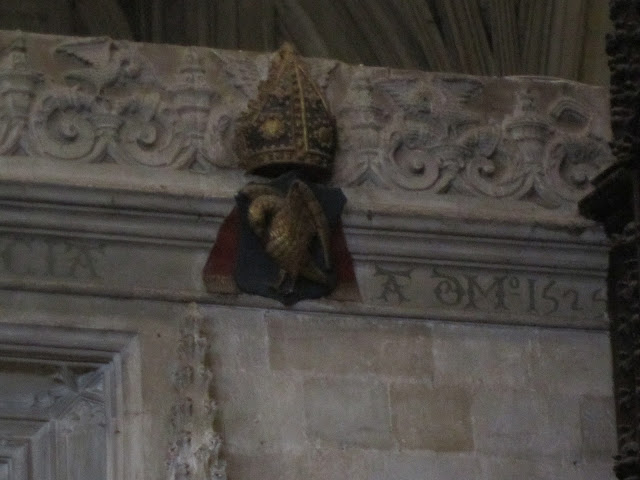Winchester was a powerful city in the middle ages, and its buildings were truly magnificent. We began our tour of the city at the hospital in the city dating back to the 14th century. This hospital was not a hospital as we would think of one, but rather was a place for poor people who had nowhere to go to find rest and a good meal. We talked with one of the brothers at the hospital whose order dated back to the saxon period. The architecture was very amazing, especially in the giant chapel, which was massively tall, though short lengthwise.
After the hospital, we walked to a ruined castle built by William Wickham, the bishop of Winchester during the civil war between King Steven and his half-sister Matilda. The castle was complimented by a massive palace, wherein our guide, Dr. Jonathan Kirkpatrick, took his confirmation classes. The palace had a massive stained glass window done in a gothic style. it can be seen below.
We next walked past Winchester College, a classic example of the hoity-toity british public school system. It is an all boys high school, built in the 1300's and was truly remarkable as well. Right next door was the house in which Jane Austen died, bearing a green sign with an indicator of the event thereupon.
We followed the road further and walked through the king's gate up to the magnificent Winchester cathedral, boasting the longest nave, or main hall, in all of England. The cathedral combines Romanesque architecture with beautiful gothic architecture which was added later. As we entered the cathedral, a full choir was singing the five mystical songs of Ralph Vaughan Williams, making it difficult to hear Simon, our other guide, but filling the space with a transcendent and heavenly feeling. We were shown the monument to Jane Austen, and then the radiator beneath which her moral remains were interred. Apparently, her grave marker had to be moved when the heating was put in, but strangely not her body, though. When we finally reached the high altar of the cathedral, our guide was yet again drowned out by the glorious sound of the organist playing "Let all the World in Every Corner Sing", to which I sang along under my breath.
Our final stop before returning to Oxford was a court holding the round table of King Arthur, or rather an old table that King Henry VIII decided to use as propaganda to make it out that he was a descendent of King Arthur. The table hung ceremoniously on the wall, and had a painting of a king at the top of it, which modern technology reveals was once a depiction of Henry VIII himself. The walls were decorated with the names of every parliamentarian up to the 1870's, and there were two massive silver doors which looked like something out of Game of Thrones. I hope you all enjoy the pictures! They will unfortunately not be as good as the last bunch. I am not as good a photographer as my friend Elizabeth, who took the last set.
 |
| Roman Mosaic...kind of a let down... |
 |
| Jane Austen's radiator |
 |
| The Round Table |
 |
| Victoria Regina |



























































